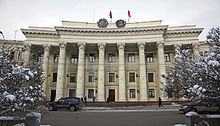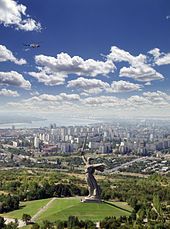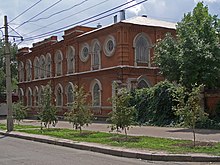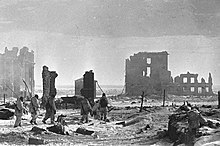Volgograd
Volgograd Волгоград | |||
|---|---|---|---|
 Counterclockwise: The Motherland Calls, the railway station, Planetarium, The Metrotram, Panorama of the City, Gerhardt Mill, Mamayev Kurgan | |||
| |||
| Anthem: none[3] | |||
show Location of Volgograd | |||
| Coordinates: 48°42′N 44°31′E / 48.700°N 44.517°ECoordinates: 48°42′N 44°31′E / 48.700°N 44.517°E | |||
| Country | Russia | ||
| Federal subject | Volgograd Oblast[2] | ||
| Founded | 1589[4] | ||
| City status since | the end of the 18th century[1] | ||
| Government | |||
| • Body | City Duma[5] | ||
| • Head[5] | Alexander Chunakov[citation needed] | ||
| Area | |||
| • Total | 859 km2 (332 sq mi) | ||
| Elevation | 80 m (260 ft) | ||
| Population | |||
| • Total | 1,021,215 | ||
| • Estimate (2018)[7] | 1,013,533 | ||
| • Rank | 12th in 2010 | ||
| • Density | 1,200/km2 (3,100/sq mi) | ||
| • Subordinated to | city of oblast significance of Volgograd[2] | ||
| • Capital of | Volgograd Oblast[2], city of oblast significance of Volgograd[2] | ||
| • Urban okrug | Volgograd Urban Okrug[8] | ||
| • Capital of | Volgograd Urban Okrug[8] | ||
| Time zone | UTC+4 (MSK+1 | ||
| Postal code(s)[10] | 400000–400002, 400005–400012, 400015–400017, 400019–400023, 400026, 400029, 400031–400034, 400036, 400038–400040, 400042, 400046, 400048–400055, 400057–400059, 400062–400067, 400069, 400071–400076, 400078–400082, 400084, 400086–400089, 400093, 400094, 400096–400098, 400105, 400107, 400108, 400110–400112, 400117, 400119–400125, 400127, 400131, 400136–400138, 400700, 400880, 400890, 400899, 400921–400942, 400960–400965, 400967, 400970–400979, 400990–400993 | ||
| Dialing code(s) | +7 8442 | ||
| City Day | Second Sunday of September[1] | ||
| Twin towns | Coventry, Ostrava, Kemi, Liège, Dijon, Turin, Port Said, Chennai, Hiroshima, Reinickendorf, Chemnitz, Ruse, Jilin City, Kruševac, Tiraspol, Płońsk, Sandanski, Orlando, Olevano Romano, Cleveland, Toronto, Chengdu, Yerevan, İzmir, Ortona, Cologne, Kiev | ||
| OKTMO ID | 18701000001 | ||
| Website | www | ||
Volgograd (Russian: Волгогра́д, IPA: [vəɫɡɐˈɡrat] (![]() listen)), formerly Tsaritsyn (Russian:
listen)), formerly Tsaritsyn (Russian: ![]() Цари́цын (help·info)), 1589–1925, and Stalingrad (Russian:
Цари́цын (help·info)), 1589–1925, and Stalingrad (Russian: ![]() Сталингра́д (help·info)), 1925–1961, is an important industrial city and the administrative centre of Volgograd Oblast, Russia.[11]
Сталингра́д (help·info)), 1925–1961, is an important industrial city and the administrative centre of Volgograd Oblast, Russia.[11]
It lies on the western bank of the Volga River. The Battle of Stalingrad in World War II was one of the largest and bloodiest battles in the history of warfare. Known locally as the "Hero City", it is home to The Motherland Calls, an 85 meter statue dedicated to the heroes of the battle. The city also has many tourist attractions, such as museums, sandy beaches, and a self-propelled floating church. Its population was 1,021,215 at the 2010 Census, growing from 1,011,417 in the 2002 Census.
Contents
History
Tsaritsyn
Although the city may have originated in 1555, documented evidence of Tsaritsyn at the confluence of the Tsaritsa and Volga rivers dates only from 1589.[4] Grigori Zasekin established the fortress Sary Su (the local Tatar-language name means "yellow water" or "yellow river") as part of the defences of the unstable southern border of the Tsardom of Russia. The structure stood slightly above the mouth of the Tsaritsa River on the right bank. It soon became the nucleus of a trading settlement.
In 1607 the fortress garrison rebelled against the troops of Tsar Vasili Shuisky for six months. In 1608 the city acquired its first stone church, St. John the Baptist. At the beginning of the 17th century, the garrison consisted of 350 to 400 people.
In 1670 troops of Stepan Razin captured the fortress; they left after a month. In 1708 the insurgent Cossack Kondraty Bulavin (died July 1708) held the fortress. In 1717 in the Kuban pogrom, raiders from the Kuban under the command of the Crimean Tatar Bakhti Gerai blockaded the town and enslaved thousands in the area. In August 1774 Yemelyan Pugachev unsuccessfully attempted to storm the city.
In 1691 Moscow established a customs-post at Tsaritsyn. In 1708 Tsaritsyn was assigned to the Kazan Governorate; in 1719[citation needed] to the Astrakhan Governorate. According to the census in 1720, the city had a population of 408 people. In 1773 the city became a provincial and district town. From 1779 it belonged to the Saratov Viceroyalty. In 1780 the city came under the newly-established Saratov Governorate.

In the 19th century Tsaritsyn became an important river-port and commercial center. The population expanded rapidly, increasing from fewer than 3,000 people in 1807 to about 84,000 in 1900. The first railway reached the town in 1862. The first theatre opened in 1872, the first cinema in 1907. In 1913 Tsaritsyn got its first tram-line, and the city's first electric lights were installed in the city center.
During the Russian Civil War of 1917–1923, Tsaritsyn came under Soviet control from November 1917. In 1918 White troops under the Ataman of the Don Cossack Host, Pyotr Krasnov, besieged Tsaritsyn. The Reds repulsed three assaults by the Whites. However, in June 1919 the White Armed Forces of South Russia under the command of General Denikin captured Tsaritsyn, which they held until January 1920. The fighting from July 1918 to January 1920 became known as the Battle for Tsaritsyn.
Stalingrad
The city was renamed Stalingrad after Joseph Stalin on April 10, 1925.[12][13] This was officially to recognize the city and Stalin's role in its defense against the Whites between 1918 and 1920.[14] In 1931, the German settlement-colony Old Sarepta (founded in 1765) became a district of Stalingrad. Renamed Krasnoarmeysky Rayon (or "Red Army District"), it became the largest area of the city.
The first institute was opened in 1930. A year later, the Stalingrad Industrial Pedagogical Institute, now Volgograd State Pedagogical University, was opened.
Under Stalin, the city became a center of heavy industry and transshipment by rail and river. During World War II, German and Axis forces attacked the city, and in 1942 it became the site of one of the pivotal battles of the war. The Battle of Stalingrad had perhaps the greatest casualty figures of any single battle in the history of warfare (estimates are between 1,250,000[15] and 1,798,619[16]). The battle became a titanic struggle between Hitler and Stalin as both saw it of great propaganda value, each keenly aware of the namesake of the city, and each poured hundreds of thousands of men into the battle.[citation needed]
The battle began on August 23, 1942, and on the same day, the city suffered heavy aerial bombardment that reduced most of it to rubble. By September, the fighting reached the city center. The fighting was of unprecedented intensity; the city's central railway station changed hands thirteen times, and the Mamayev Kurgan (one of the highest points of the city) was captured and recaptured eight times. By early November, the German forces controlled 90 percent of the city and had cornered the Soviets in two narrow pockets, but they were unable to eliminate the last pockets of Soviet resistance before Soviet forces launched a huge counterattack on November 19. This led to the encirclement of the German Sixth Army and other Axis units. on January 31, 1943 the Sixth Army's commander, Field Marshal Friedrich Paulus, surrendered, and by February 2, with the elimination of straggling German troops, the Battle of Stalingrad was over. In 1945 the Soviet Union awarded Stalingrad the title Hero City for its resistance. Great Britain's King George VI awarded the citizens of Stalingrad the jeweled "Sword of Stalingrad" in recognition of their bravery.
A number of cities around the world (especially those that had suffered similar wartime devastation) established sister, friendship and twinning links (see list below) in the spirit of solidarity or reconciliation. one of the first "sister city" projects was that established during World War II between Stalingrad and Coventry in the United Kingdom – both suffered extensive devastation from aerial bombardment.
Volgograd

On 10 November 1961, Nikita Khrushchev's administration changed the name of the city to Volgograd ("Volga City") as part of his programme of de-Stalinization following Stalin's death, as he was trying to reduce the "cult of personality". This action was and remains somewhat controversial, given Stalingrad's importance as a symbol of resistance during the war. During Konstantin Chernenko's brief administration in 1984, proposals were floated to revive its historic name. There remains a strong degree of local support for a reversion but intermittent proposals have yet to be accepted by the Russian government.
On May 21, 2007, the Communist Party obtained an important success in the Volgograd mayoral election. Communist candidate Roman Grebennikov was elected as mayor with 32.47% of the vote. Grebennikov is Russia's youngest mayor of a federal subject administrative center.
In 2010, Russian monarchists and leaders of the Orthodox organizations demanded that the city should return to its original name Tsaritsyn, but the authorities rejected their proposal.
On January 30, 2013, the Volgograd City Council passed a measure to use the title "Hero City Stalingrad" in city statements on nine specific dates annually.[17][18][19] on the following dates the title "Hero City Stalingrad" can officially be used in celebrations:
- February 2 (end of the Battle of Stalingrad),
- February 23 (Defender of the Fatherland Day),
- May 9 (Victory Day),
- June 22 (start of Operation Barbarossa),
- August 23 (start of the Battle of Stalingrad),
- September 2 (Victory over Japan Day),
- November 19 (start of Operation Uranus),
- December 9 (Day of the Fatherland's Heroes)[17]
In addition, 50,000 people signed a petition to Vladimir Putin, asking that the city's name be permanently changed to Stalingrad.[18] President Putin has replied that such a move should be preceded by a local referendum and that the Russian authorities will look into how to bring about such a referendum.[20]
Terrorist attacks
On August 24, 2004, the Volga-AviaExpress Flight 1353,[21] a Tupolev Tu-134 aircraft flying from Moscow to Volgograd, exploded in mid-air and crashed as a result of suicide terrorist attack. 34 passengers and 9 crew members were on board the aircraft, all of whom died in the crash. A Siberia Airlines flight bound for Sochi that day was also bombed, killing all 46 who were on board.
At approximately 2:00 p.m. on Monday 21 October 2013 Russian intelligence officers reported a bomb carried by a female suicide bomber exploded on a passenger bus carrying 40 people while stopped at the Lesobaza bus stop.[22] Irina Gogolyeva, a spokesperson from the Russian Emergency Situations Ministry, reported that at least five people died in the blast and seventeen others were injured.[23] on October 22, 2013, Vladimir Markin from Russia's investigative Committee reported that the suicide bomber had been identified as 30-year-old Naida Asiyalova of Dagestan.[24]
On December 29, 2013, a suicide bomb attack occurred at the Volgograd railway station, killing at least seventeen people. It is not clear how many bombers were involved or who they were.[25] The following day a suicide bombing on a trolleybus killed at least fifteen people.[26]
Politics
In 2011, the City Duma canceled direct election of the mayor and confirmed the position of City Manager. This was short-lived, as in March 2012, Volgograd residents voted for relevant amendments to the city charter to reinstate the direct mayoral elections.[27]
Administrative and municipal status
Volgograd is the administrative center of Volgograd Oblast.[28] Within the framework of administrative divisions, it is incorporated as the city of oblast significance of Volgograd—an administrative unit with the status equal to that of the districts.[2] As a municipal division, the city of oblast significance of Volgograd is incorporated as Volgograd Urban Okrug.[8]
Economy
Modern Volgograd remains an important industrial city. Industries include shipbuilding, oil refining, steel and aluminum production, manufacture of machinery and vehicles, and chemical production. The large Volgograd Hydroelectric Plant is a short distance to the north of Volgograd.
Transportation
Volgograd is a major railway junction served by the Privolzhskaya Railway. Rail links from the Volgograd railway station include Moscow; Saratov; Astrakhan; the Donbas region of Ukraine; the Caucasus and Siberia. It stands at the east end of the Volga–Don Canal, opened in 1952 to link the two great rivers of Southern Russia. European route E40, the longest European route connecting Calais in France with Ridder in Kazakhstan, passes through Volgograd. The M6 highway between Moscow and the Caspian Sea also passes through the city. The Volgograd Bridge, under construction since 1995, was inaugurated in October 2009.[29] The city river terminal is the center for local passenger shipping along the Volga River.
The Volgograd International Airport provides air links to major Russian cities as well as Antalya, Yerevan and Aktau.
Volgograd's public transport system includes a light rail service known as the Volgograd metrotram. Local public transport is provided by buses, trolleybuses and trams.
The Volga River still is a very important communication channel.
Volgograd hosts one of the few floating churches in the world:[30] the floating church of Saint Vladimir of Volgograd.
Trolza-5275 low-entry trolleybus
Climate
Under the Köppen climate classification Volgograd has a dry humid continental climate (Dfa) with a hot summer subtype.[31]
| hideClimate data for Volgograd | |||||||||||||
|---|---|---|---|---|---|---|---|---|---|---|---|---|---|
| Month | Jan | Feb | Mar | Apr | May | Jun | Jul | Aug | Sep | Oct | Nov | Dec | Year |
| Record high °C (°F) | 12.3 (54.1) | 15.9 (60.6) | 20.5 (68.9) | 29.2 (84.6) | 37.2 (99.0) | 40.1 (104.2) | 40.9 (105.6) | 42.7 (108.9) | 37.8 (100.0) | 31.0 (87.8) | 18.5 (65.3) | 12.3 (54.1) | 42.7 (108.9) |
| Average high °C (°F) | −3.5 (25.7) | −3.3 (26.1) | 3.3 (37.9) | 14.5 (58.1) | 21.4 (70.5) | 26.6 (79.9) | 29.3 (84.7) | 28.1 (82.6) | 21.3 (70.3) | 12.7 (54.9) | 3.4 (38.1) | −2.0 (28.4) | 12.7 (54.9) |
| Daily mean °C (°F) | −6.3 (20.7) | −6.6 (20.1) | −0.5 (31.1) | 9.2 (48.6) | 15.9 (60.6) | 21.0 (69.8) | 23.7 (74.7) | 22.3 (72.1) | 15.6 (60.1) | 8.1 (46.6) | 0.3 (32.5) | −4.7 (23.5) | 8.2 (46.8) |
| Average low °C (°F) | −9.2 (15.4) | −9.9 (14.2) | −4.0 (24.8) | 4.1 (39.4) | 10.1 (50.2) | 15.1 (59.2) | 17.5 (63.5) | 16.2 (61.2) | 10.3 (50.5) | 3.9 (39.0) | −2.5 (27.5) | −7.6 (18.3) | 3.7 (38.7) |
| Record low °C (°F) | −33.0 (−27.4) | −32.5 (−26.5) | −25.8 (−14.4) | −12.8 (9.0) | −1.1 (30.0) | 1.1 (34.0) | 7.2 (45.0) | 4.5 (40.1) | −1.5 (29.3) | −12.2 (10.0) | −25.8 (−14.4) | −27.8 (−18.0) | −33.0 (−27.4) |
| Average precipitation mm (inches) | 38 (1.5) | 30 (1.2) | 28 (1.1) | 28 (1.1) | 39 (1.5) | 41 (1.6) | 35 (1.4) | 30 (1.2) | 29 (1.1) | 29 (1.1) | 34 (1.3) | 45 (1.8) | 406 (16.0) |
| Average rainy days | 9 | 7 | 8 | 12 | 12 | 12 | 11 | 8 | 10 | 11 | 12 | 11 | 123 |
| Average snowy days | 20 | 18 | 11 | 2 | 0.03 | 0 | 0 | 0 | 0.1 | 1 | 9 | 18 | 79 |
| Average relative humidity (%) | 88 | 86 | 81 | 64 | 57 | 56 | 53 | 51 | 61 | 73 | 86 | 89 | 70 |
| Mean monthly sunshine hours | 66.1 | 96.9 | 138.4 | 204.2 | 290.8 | 308.4 | 329.3 | 300.2 | 228.9 | 155.8 | 63.6 | 42.5 | 2,225.1 |
| Source #1: Pogoda.ru.net[32] | |||||||||||||
| Source #2: Weatherbase (sun only)[33] | |||||||||||||
Culture and recreation


A memorial complex commemorating the battle of Stalingrad, dominated by an immense allegorical sculpture The Motherland Calls, was erected on the Mamayev Kurgan, the hill that saw some of the most intense fighting during the battle. At 85 metres it is almost twice the height of the Statue of Liberty in New York.
The Panorama Museum sited on the Volga contains artifacts from World War II. These include a panoramic painting of the battlefield from the location of the monument on Mamayev Kurgan. A rifle of the famous sniper Vasily Zaytsev is also on display.
The Musical Instrument Museum is a branch of the Volgograd regional Museum of local lore.
Education
Higher education facilities include:
- Volgograd State University
- Volgograd State Technical University (former Volgograd Polytechnical University)[34]
- Volgograd State Agriculture University
- Volgograd State Medical University[35]
- Volgograd State University of Architecture and Civil Engineering
- Volgograd Academy of Industry
- Volgograd Academy of Business Administration[36]
- Volgograd State Pedagogical University
Sports

'흑해 주위 River, cities' 카테고리의 다른 글
| <펌> Ochakiv (0) | 2019.04.18 |
|---|---|
| <펌> Danube River (0) | 2019.02.10 |
| <펌>Arheimar (capital of Goths at Denieper river) (0) | 2019.02.10 |
| <펌> Volga River (0) | 2019.02.07 |
| <펌> Tanais (0) | 2019.02.06 |

















